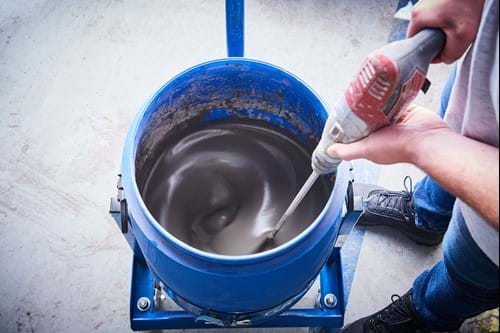Select High-Flow Self-Leveling Underlayments to Create Super Smooth Surfaces


For years, installers have counted on self-leveling underlayments (SLUs) to prepare subfloors for tile installations. Understanding different technologies can help you select the right SLU and save time and money on your job. There are two main types of self-leveling underlayments: traditional and high-flow technologies. The most noticeable differences are the flowability and the surface profile of each product.
Traditional vs. High Flow SLUs
Traditional SLUs are cement-based. Jobsite planning is critical due to the relatively short working time and extended cure times of traditional SLUs. Installers are required to help move the product around obstacles and to reach perimeters.
High flow SLUs are made with calcium aluminate, resulting in longer working times, rapid strength development and reduced cure times. With improved benefits, high flow SLUs are formulated for successful fast track and large format tile installations. TEC® Level Set® 500 HF is a high-flow SLU that affords time and labor savings. To learn more, watch the video.
To get the most out of your high-flow SLU, follow these 7 helpful tips:
1. Select a Product Appropriate for the Installation
2. Know Your Substrate
3. Prepare Your Substrate
4. Ensure Proper Water Demand
5. Ensure Appropriate Product and Ambient Temperature
6. Use as Recommended
7. Protect Your Freshly Poured Underlayment
Selecting Your Product
Know your installation environment and familiarize yourself with the relevant ASTM standards for strength. A commercial floor subject to heavy rolling loads requires a higher-grade SLU than a residential floor. With a wide range of curing times, select the SLU that works with your schedule.
Know Your Substrate
Most SLUs require that all surfaces are fully stable and structurally sound prior to the application. Understanding your existing substrate porosity is critical to choosing the proper primer. (A simple water droplet test will determine the surface porosity per ASTM F3191.)
Equally important, is the make-up of the existing substrate. Sound concrete requires a single coat of primer. Unsealed Gypcrete® may require additional steps, including multiple coats of primer prior to the application of cement-based self-leveling underlayment. TEC’s Multipurpose Primer can be used straight or with varying dilution ratios in one or two coats allowing installers to use one product for all approved substrates.
Prepare Your Substrate
Make sure to plug all floor openings, gaps and cracks and install termination dams to prevent any seepage. SLUs require substrates to be free from any contaminants that may inhibit bond. Polished underlayments may require additional steps and you should contact a manufacturer’s technical advisor.
Ensure Proper Water Demand
Mix your SLU to the water demand specified. Overwatering will lower the strength and may cause cracking and debonding. Additionally, a white film may form on the surface of the cured underlayment if the product is overwatered.
Failure to properly mix the SLU may make it difficult to work with and lead to improper flow, cracking or an irregular surface. Mix a minimum of two bags at a time when barrel mixing to ensure optimum efficiencies during the application.
Some high-flow SLUs can be pumped. If pumping, special attention is needed to maintain proper water ratios and prevent overwatering. Follow equipment and product manufacturer’s recommendations when pumping self-leveler.
High-flow SLUs can be poured easily, flowing into corners and hard to reach areas. Additionally, voids are filled with no evidence of divots or surface imperfections the next day.

Ensure Acceptable Product and Ambient Temperature
Make sure that the room temperature is within the manufacturer’s acceptable range. A climate that is too cold or too hot can affect the product, such as increased set time in cool temperatures or reduction in heal time in hot environments. No matter which type of SLU you choose, temperature and humidity will affect flow, working time and set time.
Additionally, the temperature of the powder and water is crucial. Leaving product in the sun, or in a hot environment, may lead to flash setting. In situations where warm product is unavoidable, mixing with cold water may help combat installation issues.
Use as Recommended
Manufacturers will specify the maximum thickness of their products. Some products allow for the addition of aggregate (pea gravel) to increase the depth of the pour, while others only allow their product to be used neat or require multiple pours.
Protect Your Freshly Poured Underlayment
All SLUs should be protected from direct air movement (drafts) during the initial curing process as they may cure prematurely which leads to cracking.
Generally, most underlayments are not considered final wear layer surfaces. During the final curing process (2-24 hours), they should be protected from excessive construction. Traffic without protection can lead to gouging, cracking, and disbonding. Allow the SLU to cure completely to prevent any unnecessary surface damage, prior to the installation.
As standards emerge for large and gauged porcelain panels, proper surface preparation is required. High-flow SLUs will help installers meet and exceed the new standards. Always follow manufacturer’s instructions and industry standards when using high-flow SLUs to guarantee a long-lasting flooring and ensure a successful installation.
###
TEC® and Level Set® are registered trademarks of H.B. Fuller Construction Products Inc. Gypcrete® is a registered trademark of Maxxon Corporation.
